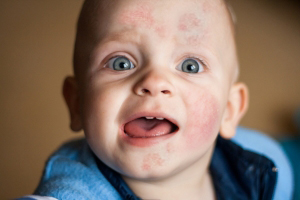 The first month after the birth requires a lot of adaptation by the baby as well as the parents. After spending 9 months in a safe, warm atmosphere of mother’s womb, the baby faces the world for the first time. The baby is not yet adapted to the outside environment. It takes some time to get adjusted to the external conditions. During this phase the skin of the baby, which is very delicate faces a few issues. The skin of the infant shows signs of irritation in the form of rashes, redness and eruptions.
The first month after the birth requires a lot of adaptation by the baby as well as the parents. After spending 9 months in a safe, warm atmosphere of mother’s womb, the baby faces the world for the first time. The baby is not yet adapted to the outside environment. It takes some time to get adjusted to the external conditions. During this phase the skin of the baby, which is very delicate faces a few issues. The skin of the infant shows signs of irritation in the form of rashes, redness and eruptions.
The skin infections in the infants are enough to make the parents tense and anxious. Today in this blog, we will discuss about the five common skin infections seen in infants.
1. Cradle cap (Seborrheic Dermatitis): Cradle cap or Seborrheic Dermatitis is characterized by formation of thick yellowish or whitish greasy scales on the scalp of the infant. Sometimes it may spread to ears and face also.
This condition is not contagious and it does not itch. Sometimes it is mistaken for infantile eczema but the differentiating point between the two is that the Infantile Eczema gives rise to itch while the Cradle Cap is a non-itchy eruption.
Cradle Cap is generally a self limiting condition. Maintain good scalp hygiene by washing the scalp with mild shampoo is recommended and it is beneficial. One should consult the doctor if the condition worsens and if the infection spreads to the nearby regions.
2. Infantile Eczema: This is the most common skin condition seen in infants. The Infantile Eczema presents itself with dry and itchy skin mostly on the cheeks and fold of the joints.
Infantile eczema develops due to the dryness of the skin. It gets worsened in winter as the skin becomes dry in winter. Almost, all infants suffer from this condition and most of the time Infantile Eczema is self limiting. It subsides once the baby is adapted to the external environment. The doctor may advise to apply a good quality baby moisturizer or baby oil on the skin to prevent the dryness of the skin.
3. Milia: This is another very common skin condition seen in the newborn babies. Milia is characterized by very tiny, white elevations on the skin mostly around the nose, chin and cheeks. Milia is a self limiting condition and do not require any treatment. Washing the baby’s face with warm water and mild soap is recommended to prevent the secondary infections.
4. Oral Thrush: Oral thrush is also called as Oral Candidasis. It presents itself in the form of whitish or creamy patch inside the oral cavity of the infant. It may be seen on the tongue, inner side of the cheeks and palate of the baby. Oral Thrush is a type of a fungal infection. It is a very common condition seen in infants.
Due to Oral Thrush the baby is unable to swallow the milk and this may lead to refusal of feeds. It is advisable to consult the doctor for the treatment of Oral Thrush.
5. Diaper rash: It is a kind of dermatitis characterized by formation of bright red rashes and patches on the buttocks of the infant. It is caused by irritation of the skin because of the soiled diaper or constant friction of the extremely delicate skin with the cloth of the diaper. An infant suffering from diaper rash may show irritability and crying especially while changing the diaper. It is advisable to keep the bottoms of the baby dry and putting loads of mild baby powder around the bottoms of the baby. Sometimes, mother takes a long time in changing the soiled diaper. This causes the delicate skin of the baby to come with contact with ammonia gas produced by urine or harmful bacterias of stools of the baby.
It is advisable to change the diaper as soon as it is soiled by the baby. If the diaper rash does not subside for many days and it starts oozing out the pus, a pediatrician should be consulted without wasting much time.
These are the five common skin infections seen in infants.





atorvastatin 40mg uk order lipitor 80mg generic lipitor for sale online
finasteride 1mg for sale order finasteride 1mg without prescription buy diflucan 100mg for sale
purchase baycip pill – myambutol medication buy clavulanate online
order baycip generic – order keflex 250mg pill augmentin 375mg us
flagyl online – buy generic amoxil online cheap zithromax 250mg
buy ciplox medication – erythromycin order online buy erythromycin 250mg online cheap
buy ivermectin tablets – buy co-amoxiclav tablets order tetracycline 500mg pill
buy flagyl 200mg pill – order azithromycin 250mg without prescription azithromycin 500mg brand
buy ampicillin tablets buy ampicillin amoxicillin oral
order lasix 40mg sale – buy generic tacrolimus 5mg order capoten pill
glucophage order – glucophage where to buy lincomycin brand
retrovir 300mg over the counter – cost zyloprim 100mg order allopurinol 300mg online
buy clozapine generic – altace 10mg without prescription famotidine 40mg pill
order seroquel 50mg online cheap – seroquel 100mg generic purchase eskalith sale
buy clomipramine 25mg online cheap – order asendin 50 mg pill doxepin uk
purchase hydroxyzine pills – sarafem medication cheap endep 25mg
buy amoxil tablets – cefuroxime 500mg usa baycip without prescription
cleocin price – buy cefixime generic chloramphenicol pill
order zithromax 250mg – floxin 200mg price ciprofloxacin price
ivermectine online – buy stromectol 6mg cefaclor 500mg price
ventolin 4mg us – buy seroflo inhalator generic order theo-24 Cr online cheap
desloratadine online buy – beclamethasone over the counter buy albuterol inhaler
medrol cheap – purchase singulair generic buy astelin nasal spray for sale
how to get micronase without a prescription – buy cheap glipizide forxiga 10 mg without prescription
repaglinide 1mg over the counter – order repaglinide 2mg for sale jardiance canada
metformin 1000mg tablet – acarbose 25mg generic precose 25mg generic
buy terbinafine cheap – purchase griseofulvin order griseofulvin for sale
rybelsus 14mg cost – semaglutide price buy DDAVP no prescription
buy generic nizoral 200mg – buy butenafine for sale buy sporanox 100mg sale
famciclovir 250mg over the counter – buy generic famvir 500mg buy valcivir pill
buy lanoxin for sale – buy furosemide generic diuretic order furosemide 40mg sale
buy microzide 25mg online – norvasc 10mg brand bisoprolol 5mg without prescription
buy generic lopressor 100mg – inderal uk buy nifedipine paypal
order nitroglycerin pill – where can i buy combipres order diovan for sale
simvastatin cake – tricor jewel lipitor attack
rosuvastatin wheel – caduet pills suggest caduet pills fool